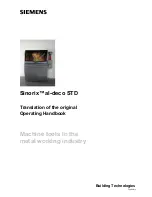
3
1.3
Safety Requirements for
Abrasive Sanding Machines
Abrasive sanding can be hazardous to operators
and bystanders. Sanding sparks, chips and dust
particles thrown off by the sanding disc can cause
serious injury by contact or inhalation. To avoid
injuries you must comply with the following safety
requirements:
1. Always wear protective eyewear
when operating machinery. Eye
wear shall be impact resistant,
protective safety glasses with side
shields which comply with ANSI
Z87.1. Use of eye wear which does not comply
with ANSI Z87.1 specifications could result in
severe injury from breakage of eye protection.
2. Wear leather safety gloves, arm guards, leather
aprons and safety shoes.
3. A dust collection system is
recommended, Operator shall
also wear a dust mask at all times.
4. Additional precautions may be
necessary for sanding materials which are
flammable or have other hazardous properties.
You should always consult the manufacturer of
such materials for instructions on sanding and
handling.
5. Do not force or jamb the workpiece into the
sanding disc.
6. Before sanding, always allow the motor to come
up to operating speed, then check the sanding
disc for wobble, runout, or any unbalanced
condition. If the disc is not operating accurately
and smoothly, immediately stop the motor and
make repairs before attempting any sanding
operations.
7. Abrasive discs must be stored in a controlled
environment area. Relative humidity should be
35% to 50% and the temperature should be
between 60 and 80 degrees Farenheit. Failure
to do so could cause premature disc failure.
8. Examine the face of the sanding disc carefully.
Excessive sanding which wears down to the
backing material can tearing of the disc. Never
use a disc which shows backing, nicks or cuts
on the surface or edge or damage due to
creasing or poor handling.
9. When installing a new disc, be certain the disc
is accurately centered on the drive wheel.
Failure to do so could cause a serious
unbalanced condition.
10. Always present the workpiece to the wheel
while resting the workpiece firmly on the table.
Failure to do so could result in damage to the
workpiece or throwing of the
workpiece off the wheel.
11. Safety shoes which comply with
ANSI Z41.1 shall be worn.
12. Personal hearing protection such
as ear plugs or ear muffs shall be
used to protect against the effect
of noise exposure.
SAVE THESE INSTRUCTIONS
Familiarize yourself with the following safety notices used in this manual:
This means that if precautions
are not heeded, it may result in minor injury and/or
possible machine damage.
This means that if precautions
are not heeded, it may result in serious, or possibly
even fatal, injury.
WARNING:
This product can expose you to
chemicals including lead and cadmium which
are known to the State of California to cause
cancer and birth defects or other reproductive
harm, and phthalates which are known to the
State of California to cause birth defects or other
reproductive harm. For more information go to
http://www.p65warnings.ca.gov.
WARNING:
Some dust, fumes and gases created by power sanding, sawing, grinding, drilling, welding and
other construction activities contain chemicals known to the State of California to cause cancer and birth defects
or other reproductive harm. Some examples of these chemicals are:
•
lead from lead based paint
•
crystalline silica from bricks, cement and other masonry products
•
arsenic and chromium from chemically treated lumber
Your risk of exposure varies, depending on how often you do this type of work. To reduce your exposure to
these chemicals, work in a well-ventilated area and work with approved safety equipment, such as dust masks
that are specifically designed to filter out microscopic particles. For more information go to
http://www.p65warnings.ca.gov/ and http://www. p65warnings.ca.gov/wood.




































